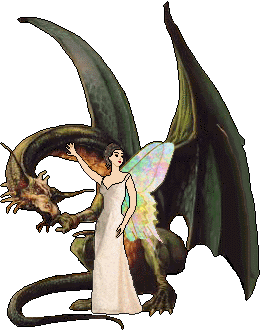The World Of Dragons



If you would like to adopt one
of your own, you can click on the certificate
below.


Dragon, a legendary reptilian monster similar in
form to a crocodile and usually represented as
having wings, huge claws, and a fiery breath. In
some folklore of antiquity, the dragon symbolizes
destruction and evil. This conception is found,
for example, in Enuma Elish, a Mesopotamian
creation epic written about 2000BC. One of the
central figures of the legend is the goddess
Tiamat, a dragonlike personification of the
oceans, who headed the hordes of chaos and whose
destruction was prerequisite to an orderly
universe. In the sacred writings of the ancient
Hebrews, the dragon frequently represents death
and evil. Christianity inherited the Hebraic
conception of the dragon, which figures in all the
important apocalyptic literature of the Bible,
notably in Revelation, and appears in later
Christian traditions. In Christian art, the dragon
is a symbol of sin. It is often represented as
crushed under the feet of saints and martyrs,
symbolizing the triumph of Christianity over
paganism.
In certain mythologies, the dragon is more
generally credited with beneficent powers. The
ancient Greeks and Romans believed that dragons
had the ability to understand and to convey to
mortals the secrets of the earth. Partially as a
result of this conception of the monster as a
benign, protective influence, and partially
because of its fearsome qualities, it was employed
as a military emblem. The Roman legions adopted it
in the first century AD, inscribing the figure of
a dragon on the standards carried into battle by
the cohorts. The folklore of the pagan tribes of
northern Europe contained both beneficent and
terror-inspiring dragons. In the Nibelungenlied,
Siegfried kills a dragon, and one of the principal
episodes of Beowulf deals with a similar
achievement. The ancient Norsemen adorned the
prows of their vessels with carved likenesses of
dragons. Among the Celtic conquerors of Britain
the dragon was a symbol of sovereignty. The
legendary monster was also depicted on the shields
of the Teutonic tribes that later invaded Britain,
and it appeared on the battle standards of the
English kings as late as the 16th century.
Beginning in the early 20th century, it was
inscribed on the armorial bearings of the Prince
of Wales.
The dragon also figures in the mythology of
various Oriental countries, notably Japan and
China. It is deified in the Daoist (Taoist)
religion and was the national emblem of the
Chinese Empire. Among the Chinese people, the
dragon is traditionally regarded as a symbol of
good fortune.
"Dragon," Microsoft® Encarta® Encyclopedia 99. ©
1993-1998 Microsoft Corporation. All rights
reserved.

Dragon Links









 
|